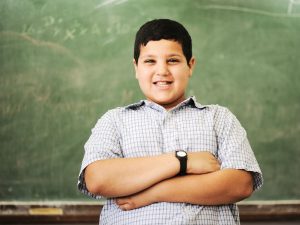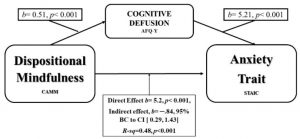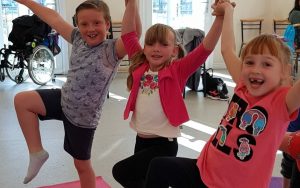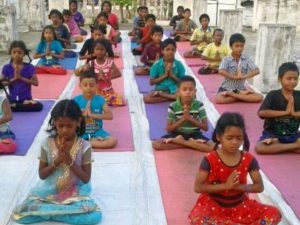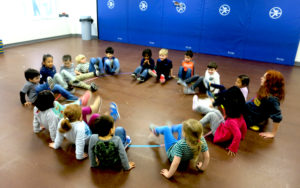Improve Body Size, Endocrine Function, and Anxiety in Anxious Obese Children with Mindfulness
By John M. de Castro, Ph.D.
“Mindfulness is a promising tool to be used as an adjunctive therapy for childhood obesity, either because of its potential to decrease stress or because it could counter act the stressful condition imposed by a restrictive dietary regimen,” – Mardia López-Alarcón
Obesity has become an epidemic in the industrialized world. In the U.S. the incidence of obesity, defined as a Body Mass Index (BMI) of 30 or above has more than doubled over the last 35 years to currently around 35% of the population, while two thirds of the population are considered overweight or obese (BMI > 25). Sadly, children and adolescents have not been spared with 1 in 5 school age children and young people (6 to 19 years) classified as obese.
Although the incidence rates have appeared to stabilize, the fact that over a third of the population is considered obese is very troubling. This is because of the health consequences of obesity. Obesity has been found to shorten life expectancy by eight years and extreme obesity by 14 years. This occurs because obesity is associated with cardiovascular problems such as coronary heart disease and hypertension, stroke, metabolic syndrome, diabetes, cancer, arthritis, and others.
Obviously, there is a need for effective treatments to prevent or treat obesity. But, despite copious research and a myriad of dietary and exercise programs, there still is no safe and effective treatment. Mindfulness is known to be associated with lower risk for obesity, alter eating behavior and improve health in obesity. This suggests that mindfulness training may be an effective treatment for overeating and obesity in children alone or in combination with other therapies. It would seem reasonable to attack the problem early in life with the children and adolescents. Hence, the benefits of mindfulness practice for obese children should be investigated.
In today’s Research News article “Mindfulness affects stress, ghrelin, and BMI of obese children: a clinical trial.” (See summary below or view the full text of the study at: https://www.ncbi.nlm.nih.gov/pmc/articles/PMC7040861/), López-Alarcón and colleagues recruited obese children and adolescents aged 10-17 years who scored high in anxiety levels and provided them with an 8-week, once a week for a half hour conventional nutritional intervention including recommendations for a 700 Kcal reduction in intake. They were then randomly assigned to receive either no further treatment or to receive an 8-week, once a week for 2 hours Mindfulness-Based Stress Reduction-Eat Mindful program based upon the Mindfulness-Based Stress Reduction (MBSR) program consisting on training in meditation, body scan, breathing exercises, mindful eating, and discussions of using mindfulness in everyday life. They were measured before and after the program and 8 weeks later for body size, perceived stress, and anxiety. Blood was drawn and assayed for insulin, cortisol, ghrelin, and leptin and a salivary sample was assayed for cortisol levels.
They found that in comparison to the baseline and the nutritional intervention only, the children and adolescents who received mindfulness training had significant reduction in anxiety levels of all forms, including phobias, generalized anxiety, obsessive-compulsive disorder, and separation anxiety. Also, there were significant reductions in body fat, cortisol, and ghrelin levels. In addition, at the 8- and 16-week follow-ups there were significant reductions in body size.
These are exciting results. Childhood obesity is major problem and the results of this study suggests that a mindfulness training program combined with a conventional nutritional intervention is safe and effective in improving the physical and psychological effects of obesity and in reducing body size. Mindfulness interventions have been shown to be effective in reducing anxiety in adults. But these programs have been found to have only small or mixed effectiveness in the treatment of adult obesity. But the present results suggest that mindfulness interventions may be particularly effective when applied to obese children and adolescents. A long-term follow up of these children is needed to determine the long-term effectiveness of mindfulness training.
So, improve body size, endocrine function, and anxiety in anxious obese children with mindfulness.
“We think mindfulness could recalibrate the imbalance in the brain connections associated with childhood obesity,” – Ronald Cowan
CMCS – Center for Mindfulness and Contemplative Studies
This and other Contemplative Studies posts are also available on Google+ https://plus.google.com/106784388191201299496/posts and on Twitter @MindfulResearch
Study Summary
López-Alarcón, M., Zurita-Cruz, J. N., Torres-Rodríguez, A., Bedia-Mejía, K., Pérez-Güemez, M., Jaramillo-Villanueva, L., Rendón-Macías, M. E., Fernández, J. R., & Martínez-Maroñas, P. (2020). Mindfulness affects stress, ghrelin, and BMI of obese children: a clinical trial. Endocrine connections, 9(2), 163–172. https://doi.org/10.1530/EC-19-0461
Abstract
Childhood obesity is associated with stress. However, most treatment strategies include only dietary and physical activity approaches. Mindfulness may assist in weight reduction, but its effectiveness is unclear. We assessed the effect of mindfulness on stress, appetite regulators, and weight of children with obesity and anxiety. A clinical study was conducted in a pediatric hospital. Eligible children were 10–14 years old, BMI ≥95th percentile, Spence anxiety score ≥55, and who were not taking any medication or supplementation. Participants were assigned to receive an 8-week conventional nutritional intervention (CNI) or an 8-week mindfulness-based intervention plus CNI (MND-CNI). Anthropometry, body composition, leptin, insulin, ghrelin, cortisol, and Spence scores were measured at baseline and at the end of the intervention. Anthropometry was analyzed again 8 weeks after concluding interventions. Log-transformed and delta values were calculated for analysis. Thirty-three MND-CNI and 12 CNI children finished interventions; 17 MND-CNI children accomplished 16 weeks. At the end of the intervention, significant reductions in anxiety score (−6.21 ± 1.10), BMI (−0.45 ± 1.2 kg/m2), body fat (−1.28 ± 0.25%), ghrelin (−0.71 ± 0.37 pg/mL), and serum cortisol (−1.42 ± 0.94 µg/dL) were observed in MND-CNI children. Changes in anxiety score, ghrelin, and cortisol were different between groups (P < 0.05). Children who completed 16 weeks decreased BMI after intervention (−0.944 ± 0.20 kg/m2, P < 0.001) and remained lower 8 weeks later (−0.706 ± 0.19 kg/m2, P = 0.001). We concluded that mindfulness is a promising tool as an adjunctive therapy for childhood obesity. However, our findings need confirmation in a larger sample population.
https://www.ncbi.nlm.nih.gov/pmc/articles/PMC7040861/
